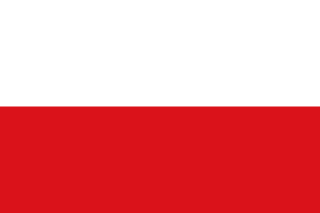
Tyrol is an Austrian federal state. It comprises the Austrian part of the historical Princely County of Tyrol. It is a constituent part of the present-day Euroregion Tyrol–South Tyrol–Trentino. The capital of Tyrol is Innsbruck.

The history of Tyrol, a historical region in the middle alpine area of Central Europe, dates back to early human settlements at the end of the last glacier period, around 12,000 BC. Sedentary settlements of farmers and herders can be traced back to 5000 BC. Many of the main and side valleys were settled during the early Bronze Age, from 1800 to 1300 BC. From these settlements, two prominent cultures emerged: the Laugen-Melaun culture in the Bronze Age, and the Fritzens-Sanzeno culture in the Iron Age.
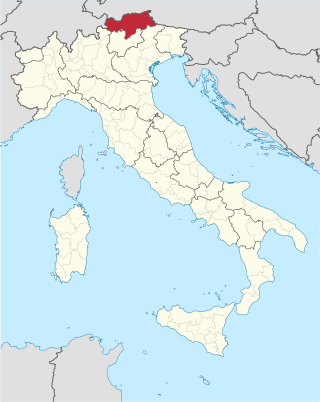
South Tyrol is an autonomous province in northern Italy. An English translation of the official German and Italian names could be the Autonomous Province of Bolzano – South Tyrol, reflecting the multilingualism and different naming conventions in the area. Together with Trentino, South Tyrol forms the autonomous region of Trentino-Alto Adige/Südtirol. The province is the northernmost of Italy, the second largest with an area of 7,400 square kilometres (2,857 sq mi), and has a total population of about 534,000 inhabitants as of 2021. Its capital and largest city is Bolzano.
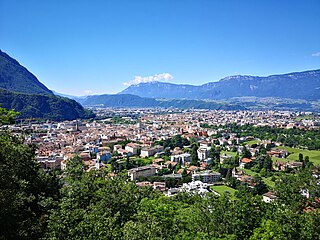
Bolzano is the capital city of South Tyrol, Northern Italy. With a population of 108,245, Bolzano is also by far the largest city in South Tyrol and the third largest in historical Tyrol. The greater metro area has about 250000 inhabitants and is one of the urban centres within the Alps.

Sepp Kerschbaumer was a terrorist member of the South Tyrolean Liberation Committee (Befreiungsausschuss Südtirol ), which campaigned for the break-away of South Tyrol from Italy. In 1961, the BAS staged the so-called Feuernacht, the destruction of several dozen electricity pylons, which escalated the South Tyrol conflict. The Italian state viewed the BAS as a terrorist and separatist organization, while large parts of the South Tyroleans regarded them as freedom fighters.
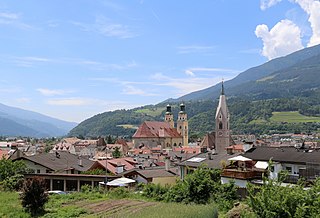
Brixen is a town and commune in South Tyrol, northern Italy, located about 40 kilometres (25 mi) north of Bolzano.
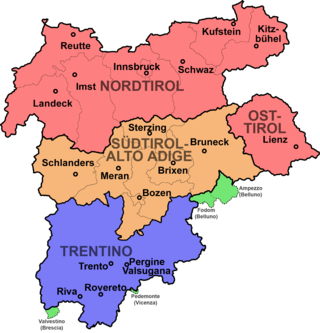
East Tyrol, occasionally East Tirol, is an exclave of the Austrian federal state of Tyrol, separated from North Tyrol by parts of Salzburg State and parts of Italian South Tyrol. It is coterminous with the administrative district (Bezirk) of Lienz.

The South Tyrol Option Agreement was an agreement in effect between 1939 and 1943, when the native German and Ladin-speaking people in South Tyrol and several other municipalities of northern Italy, which had belonged to the Austrian Empire until 1919, were given the option of either emigrating to neighboring Nazi Germany or remaining in Fascist Italy, where the German minority was subjected to repressive Italianization efforts.

Modern-day South Tyrol, an autonomous Italian province created in 1948, was part of the Austro-Hungarian County of Tyrol until 1918. It was annexed by Italy following the defeat of the Central Powers in World War I. It has been part of a cross-border joint entity, the Euroregion Tyrol-South Tyrol-Trentino, since 2001.

The (Princely) County of Tyrol was an estate of the Holy Roman Empire established about 1140. After 1253, it was ruled by the House of Gorizia and from 1363 by the House of Habsburg. In 1804, the County of Tyrol, unified with the secularised prince-bishoprics of Trent and Brixen, became a crown land of the Austrian Empire. From 1867, it was a Cisleithanian crown land of Austria-Hungary.
The South Tyrolean Liberation Committee was an underground secessionist and terrorist organisation founded by Sepp Kerschbaumer and several combatants including Georg Klotz in the mid-1950s which aimed to achieve the right for self-determination for South Tyrol and the related secession from Italy via bomb attacks.
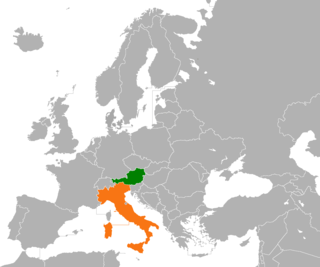
Foreign relations exist between Austria and Italy. Austria has an embassy in Rome and a consulate-general in Milan. Italy has an embassy in Vienna and a consulate in Innsbruck. Both countries are full members of the Council of Europe, European Union, Organisation for Economic Co-operation and Development, and Organization for Security and Co-operation in Europe. The countries share 420 km of common borders.

In 1919, at the time of its annexation, the middle part of the County of Tyrol, which is today called South Tyrol, was inhabited by almost 90% German speakers. Under the 1939 South Tyrol Option Agreement, Adolf Hitler and Benito Mussolini determined the status of ethnic Germans and Ladins living in the region. They could emigrate to Germany, or stay in Italy and accept their complete Italianization. As a consequence of this, the society of South Tyrol was deeply riven. Those who wanted to stay, the so-called Dableiber, were condemned as traitors while those who left were defamed as Nazis. Because of the outbreak of World War II, this agreement was never fully implemented. Illegal Katakombenschulen were set up to teach children the German language.

Tyrol is a historical region in the Alps of Northern Italy and western Austria. The area was historically the core of the County of Tyrol, part of the Holy Roman Empire, Austrian Empire and Austria-Hungary, from its formation in the 12th century until 1919. In 1919, following World War I and the dissolution of Austria-Hungary, it was divided into two modern administrative parts through the Treaty of Saint-Germain-en-Laye:
The South Tyrolean Unterland or Bozen Unterland is a section of the Etschtal valley stretching from the regional capital Bolzano (Bozen) down the Adige (Etsch) river to Tramin and Salorno (Salurn). The area is known for its history, particularly regarding Rhaetic, Roman, and Germanic archaeological sites; its bilingualism, and its viticulture; the Gewürztraminer grape originated here.
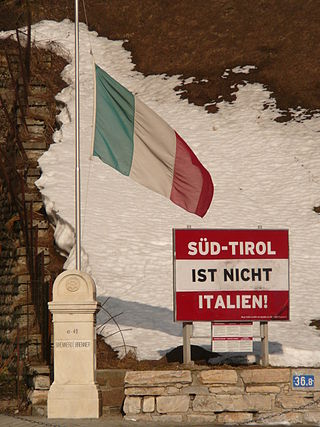
The South Tyrolean independence movement is a political movement in the Italian autonomous province of South Tyrol that calls for the secession of the region from Italy and its reunification with the State of Tyrol, Austria. Concurrently, some groups favor the establishment of an interim Free State of South Tyrol as a sovereign nation while reintegration is organized.
The Cima Vallona ambush was a double improvised explosive device attack on Italian security forces at Cima Vallona, Provincia di Belluno. The ambush was carried out on 26 June 1967 by members of the South Tyrolean Liberation Committee, a paramilitary organization seeking the independence of German-speaking South Tyrol from Italy. The first explosion, involving the use of a landmine, struck a patrol of Alpini from the Italian Army, called in after the bombing of an electricity pylon. A second patrol, this time composed by Carabinieri, bore the full blast of a booby-trap while searching the area of the previous attack. One Alpini and three Carabinieri were killed, while a fourth Carabiniere survived with serious injuries.
The Malga Sasso bombing was a major bomb attack on an Italian Guardia di Finanza outpost not far from the Brennero pass, in the Province of Bolzano, near the border with Austria. The attack was carried out on 9 September 1966 by members of the South Tyrolean Liberation Committee (BAS), a paramilitary organization seeking the independence of German-speaking South Tyrol from Italy. Two guards were killed by the blast on the spot, while a third died of wounds several days later. Three others were seriously injured. The separatist militants Alois Larch, Alois Rainer and Richard Kofler were prosecuted and sentenced by the Italian Justice in 1976.

The Sacred Heart Fires are a fire rite that originated in Tyrol in the 18th century. The fires are still lit in several parts of the Tyrol and Trentino. The custom of lighting a fire in June goes back to the earlier solstice of St. John's fires, which were reinterpreted in memory of the "Sacred Heart of Jesus vow" of 1796.
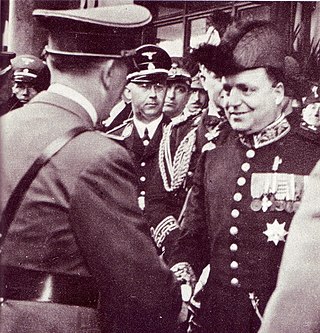
Giuseppe Mastromattei was an Italian Fascist politician and civil servant, who served as prefect of Bolzano from 1933 to 1940. He was the longest serving prefect of the province of Bolzano and oversaw the forced Italianization of South Tyrol under the Fascist regime, as well as the South Tyrol Option Agreement of 1939.













